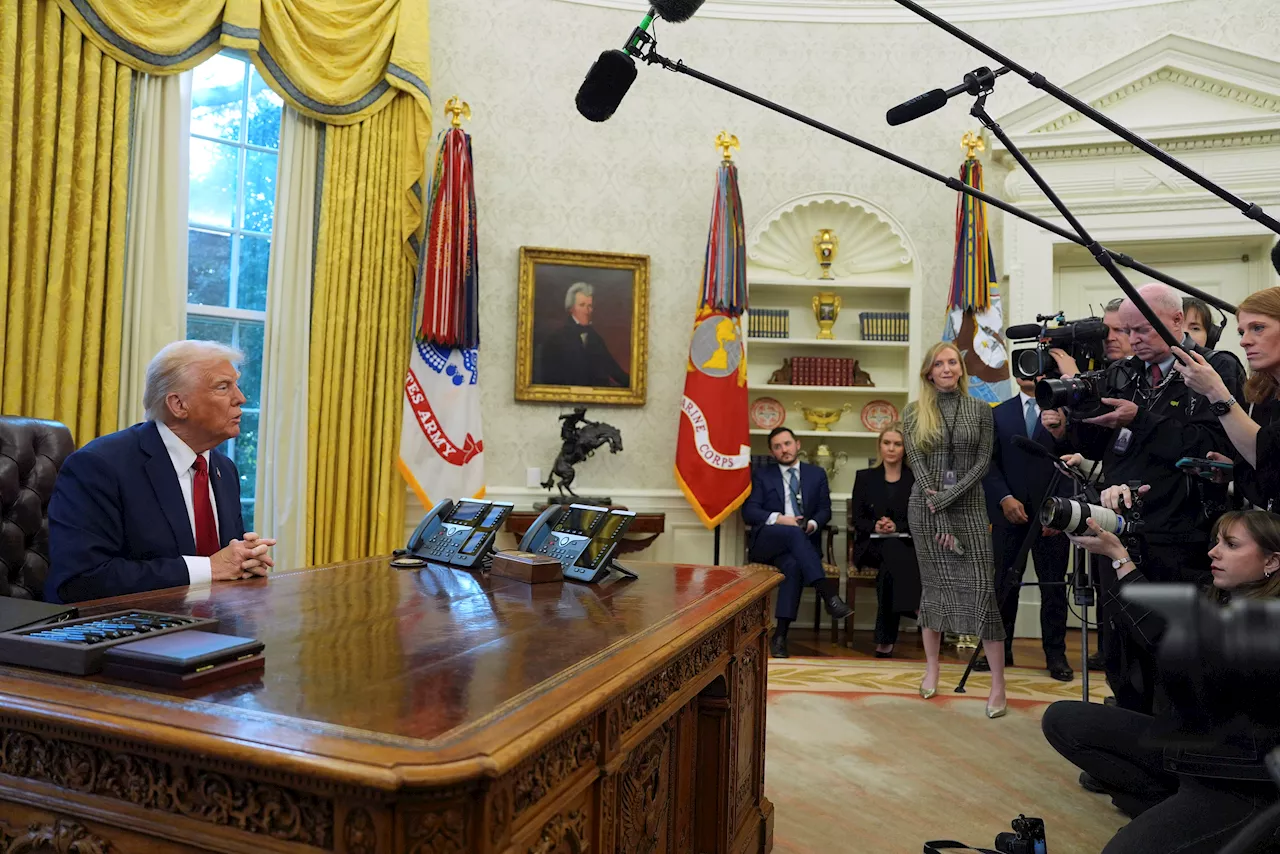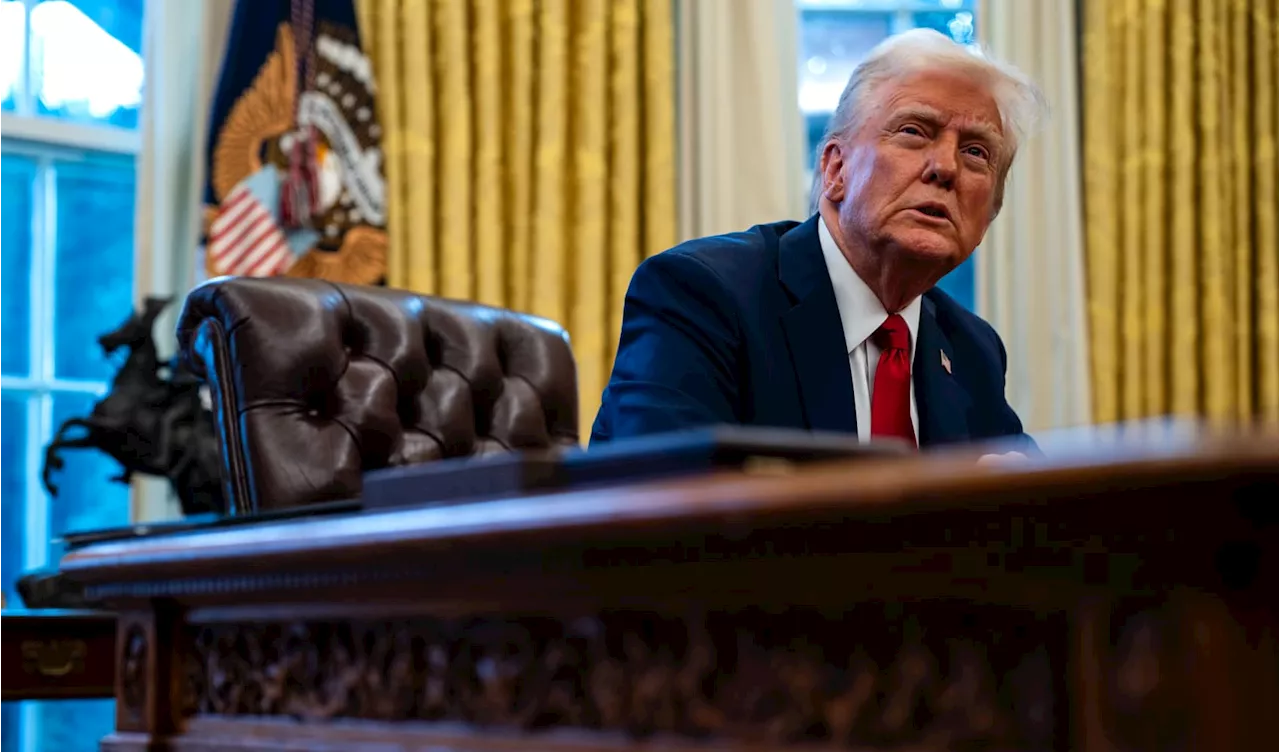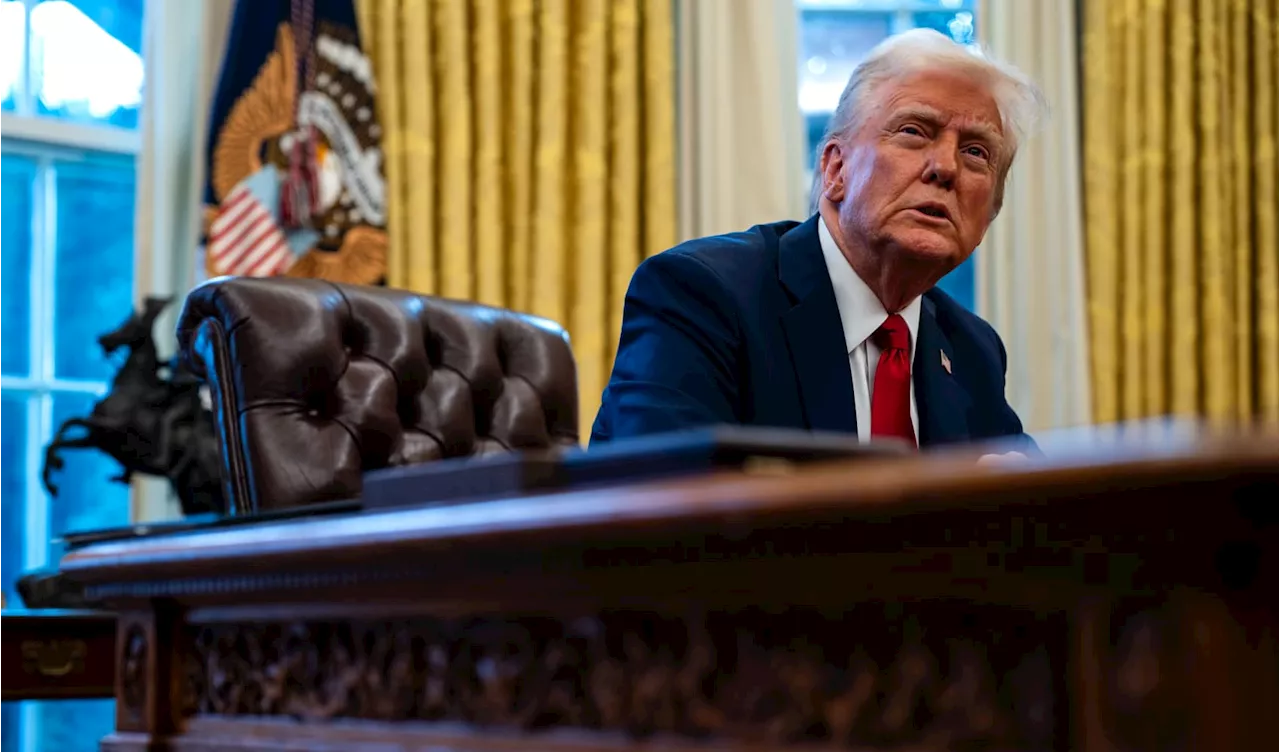President Trump's plan to impose a 25% tariff on imports from Canada and Mexico could trigger a trade war, increase consumer prices, and jeopardize the U.S.-Mexico-Canada Agreement. The move is seen as an attempt to pressure both countries on immigration and trade issues.
The 25% tax that President Trump plans to impose on imports from Canada and Mexico as soon as Saturday could drive up the price of everything from gasoline and pickup trucks to Super Bowl party guacamole dip. The tariffs would also invite retaliation. Doug Ford, the premier of Ontario, has already vowed to counterpunch by pulling American alcohol off store shelves in the Canadian province. That's no idle threat; Canada is the world’s No.
2 market for America’s distilled spirits (behind the 27-nation European Union). Trump’s tariffs threaten to blow up the trade agreement he himself negotiated with America’s neighbors in his first term. His U.S.-Mexico-Canada Agreement — “the fairest, most balanced, and beneficial trade agreement we have ever signed into law,’’ Trump once declared — was supposed to bring predictability to North American trade, giving businesses the confidence to make investments. But when it comes to the self-proclaimed “Tariff Man,’’ nothing is predictable, and nothing is ever really settled. “Tariffs at those levels and at that scope would effectively destroy the agreement that Trump himself negotiated and always brags about,’’ said Scott Lincicome, a trade analyst at the libertarian Cato Institute. The president says the 25% levies are designed to pressure America’s two neighbors to do more to stop the flow of unauthorized immigrants and fentanyl into the United States. Michael Robinet of S&P Global Mobility and many other analysts suspect the tariff threat is also designed to get Canada and Mexico to go along with America’s demands for changes to the USMCA pact when it comes up for renewal next year. Robinet, executive director of automotive consulting at S&P Global, said he doubts that Trump will go ahead with 25% across-the-board tariffs on Canadian and Mexican imports — what he calls a “shock-to-the-system’’ approach that would freeze the North American economy in a “Tariff Winter.’’ Instead, Robinet said, Trump might postpone or phase in the tariffs or initially exempt some industries to show Canada and Mexico how much worse things could get if he doesn’t get his way. Trump pressured Mexico and Canada into agreeing to the USMCA five years ago, partly to narrow the United States’ big trade deficit — the gap between what the U.S. sells and what it buys. It hasn’t worked out that way. The U.S. deficit in the trade of goods of Mexico has widened from $106 billion in 2019 to $161 billion in 2023 (the last full year for which numbers are available). That is partly because Mexico has replaced China, locked in an ongoing trade war with the United States, as the source of many U.S. imports — furniture, textiles, shoes, laptops, computer servers. The trade gap in goods with Canada has ballooned, too: From $31 billion in 2019 to $72 billion in 2023. The deficit largely reflects America’s imports of Canadian energy. “The USMCA has not met the goals that Trump set forth for it. Our trade deficit with Canada and Mexico is bigger than it was, considerably,’’ said Lori Wallach, director of the Rethink Trade program at the American Economic Liberties Project and a longtime critic of America’s free trade pacts. “A lot of jobs have been offshored to Mexico since USMCA.’’ When the USMCA comes up for renewal next year, the U.S. is expected to press for rules that would do more to encourage factories to produce in the United States. And it could seek a crackdown on Chinese goods being sent through Mexico to the United States to evade tariffs that Trump and President Biden imposed on Beijing. The United States now does far more business — exports and imports alike — with both Canada and Mexico than it does with China. In 2023, U.S. trade of both goods and services with Canada and Mexico came to more than $1.8 trillion, compared with $643 billion with China. Because of USMCA — and the regional trade deal it replaced in 2020 — most products cross the region’s borders tariff-free. The threatened 25% tariffs are causing heartburn in corporate boardrooms. If Trump goes ahead with his threat, tariffs would surge from $1.3 billion to $132 billion a year on Mexico’s imports to the United States and from $440 million to $107 billion on Canada’s, according to the tax and consulting firm PwC. And no one knows if Trump will really pull the trigger or how long the tariffs would stay in place if he does. “It’s really thrown industry into this turmoil of anxiety,” said trade lawyer Chandri Navarro, senior counsel at Baker & McKenzie. “What industry likes is certainty. You’re making production decisions, supply chain decisions, purchasing decisions five years out.’’ Trump views tariffs as a fix-it for most of what ails the economy. He says they raise money for cuts in income and corporate taxes, encourage companies to move production to the United States and offer useful leverage in pressuring other countries to make concessions on trade and other issue
TRUMP TARIFFS CANADA MEXICO USMCA TRADE IMMIGRATION ECONOMY
United States Latest News, United States Headlines
Similar News:You can also read news stories similar to this one that we have collected from other news sources.
 Trump Threatens 25% Tariffs on Canada and Mexico, Rattling North American TradePresident Trump's potential plan to impose a 25% tax on imports from Canada and Mexico could significantly impact various sectors, from fuel and automobiles to consumer goods. The move threatens to destabilize the USMCA trade agreement, which Trump himself negotiated. While Trump argues the tariffs aim to curb the flow of illegal migrants, experts believe they are also a tactic to pressure Canada and Mexico into accepting US demands for trade agreement revisions. The tariffs could lead to a 'Tariff Winter,' freezing the North American economy.
Trump Threatens 25% Tariffs on Canada and Mexico, Rattling North American TradePresident Trump's potential plan to impose a 25% tax on imports from Canada and Mexico could significantly impact various sectors, from fuel and automobiles to consumer goods. The move threatens to destabilize the USMCA trade agreement, which Trump himself negotiated. While Trump argues the tariffs aim to curb the flow of illegal migrants, experts believe they are also a tactic to pressure Canada and Mexico into accepting US demands for trade agreement revisions. The tariffs could lead to a 'Tariff Winter,' freezing the North American economy.
Read more »
 Trump Imposes 25% Tariffs on Canada and Mexico, Weighs Oil ImportsPresident Trump announced 25% tariffs on goods from Canada and Mexico, citing concerns over illegal immigration and fentanyl. He is yet to decide if oil imports will be included, a move that could impact gas prices and inflation. Trump's threat to impose tariffs on oil has raised concerns about rising gas prices, a key issue for voters. Canada and Mexico are major oil suppliers to the U.S., and the tariffs could lead to increased costs for refineries, potentially pushing gas prices higher.
Trump Imposes 25% Tariffs on Canada and Mexico, Weighs Oil ImportsPresident Trump announced 25% tariffs on goods from Canada and Mexico, citing concerns over illegal immigration and fentanyl. He is yet to decide if oil imports will be included, a move that could impact gas prices and inflation. Trump's threat to impose tariffs on oil has raised concerns about rising gas prices, a key issue for voters. Canada and Mexico are major oil suppliers to the U.S., and the tariffs could lead to increased costs for refineries, potentially pushing gas prices higher.
Read more »
 Trump Threatens 25% Tariffs on Canada and Mexico, Weighing Oil InclusionPresident Trump announced 25% tariffs on Canadian and Mexican imports, effective Saturday, but is still deciding whether to include oil. The tariffs, aimed at curbing illegal immigration and fentanyl smuggling, could impact consumer gasoline prices and inflation. Trump pledged to cut energy prices in half during his first year, a campaign promise that resonates with voters concerned about rising fuel costs. The decision on oil tariffs could have significant economic consequences for the US and its trading partners.
Trump Threatens 25% Tariffs on Canada and Mexico, Weighing Oil InclusionPresident Trump announced 25% tariffs on Canadian and Mexican imports, effective Saturday, but is still deciding whether to include oil. The tariffs, aimed at curbing illegal immigration and fentanyl smuggling, could impact consumer gasoline prices and inflation. Trump pledged to cut energy prices in half during his first year, a campaign promise that resonates with voters concerned about rising fuel costs. The decision on oil tariffs could have significant economic consequences for the US and its trading partners.
Read more »
 Trump To Impose 25% Tariffs on Canada and Mexico, Oil Inclusion UncertainPresident Trump announced 25% tariffs on goods from Canada and Mexico, starting in February. The inclusion of oil in the tariffs remains undecided and will depend on the pricing and treatment of the U.S. by both countries.
Trump To Impose 25% Tariffs on Canada and Mexico, Oil Inclusion UncertainPresident Trump announced 25% tariffs on goods from Canada and Mexico, starting in February. The inclusion of oil in the tariffs remains undecided and will depend on the pricing and treatment of the U.S. by both countries.
Read more »
 Trump Imposes 25% Tariffs on Canada and Mexico, Oil Inclusion Still PendingPresident Trump announced 25% tariffs on goods from Canada and Mexico, citing concerns over illegal immigration and fentanyl. The decision to extend these tariffs to oil imports remains undecided, with potential impacts on gas prices and inflation. Experts warn of rising costs for consumers and refineries while Trump maintains the U.S. is self-sufficient in energy.
Trump Imposes 25% Tariffs on Canada and Mexico, Oil Inclusion Still PendingPresident Trump announced 25% tariffs on goods from Canada and Mexico, citing concerns over illegal immigration and fentanyl. The decision to extend these tariffs to oil imports remains undecided, with potential impacts on gas prices and inflation. Experts warn of rising costs for consumers and refineries while Trump maintains the U.S. is self-sufficient in energy.
Read more »
 Trump Imposes 25% Tariffs on Canada and Mexico, Oil Inclusion UncertainPresident Trump announces 25% tariffs on goods from Canada and Mexico, citing immigration, drug trafficking, and trade deficits as reasons. The inclusion of oil in the tariffs remains undecided, pending negotiations and the price of oil.
Trump Imposes 25% Tariffs on Canada and Mexico, Oil Inclusion UncertainPresident Trump announces 25% tariffs on goods from Canada and Mexico, citing immigration, drug trafficking, and trade deficits as reasons. The inclusion of oil in the tariffs remains undecided, pending negotiations and the price of oil.
Read more »
